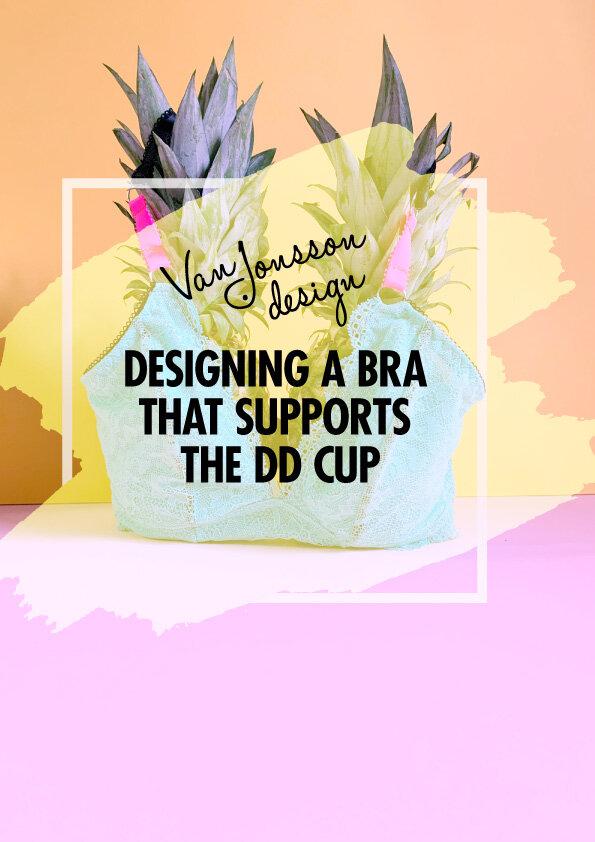Designing a bra that supports the DD cup
If you are designing bras that are for the DD cup and above, then there are a few things to think about. Before we go any further though, I think we need to remember the weight of boobs above a 32DD cup (or 34D cup) , is between 2lb+ whilst FF boobs can weight up to 5lb+ (0.9, 2.3kg respectively), the weight difference tends to be due to the density of your breasts.
So if you’re a DD thats the equivalent of strapping a pineapple, box or wine (there’s a great idea) or a bag of sugar to your chest. Or if you’re a FF cup that’s like carrying two pineapples on your chest .
So bare (pun intended) that in mind whilst wondering why you can’t put tiny delicate straps on your garment.
Now whilst I go through the different things you need to think of, this obviously is a guide if you are aiming at super duper comfy fitting lingeire. There is nothing wrong with not having any of these suggestions, in fact the world be a terrible place, if all we had was lingerie structured in a certain way. Lingerie is meant to be fun, but if you have the fortunate (or unfortunate depending which way your view is) size boobs over a DD it can be so a heartbreaking to see what is out there, that’s comfy, gives support and actually something you like.
If you are determined to be designing bras that use luxury silks or satins, delicate lace, beautiful mesh you totally can. By knowing what works in the larger cup size fit wise, that’s when you can start to line your bra in silk, and use lace that you only usually see on smaller cups.
Now designing for bigger boobs does take a different strategy than designing for the smaller chest. With all that weight you need to ensure you have a correct style under-band. The under-band is basically designed like a bridge, it takes the weight of the breasts and distributes the weight across the under-band. If you’re under-band is rising up at the back then the bra simply isn’t doing it’s job. A good power-net is recommended, one which feels firm yet when stretches out has a good recovery (is able to return to it’s original size and not be wavy).
So if your under-band has to be snug, then obviously it can’t have thin elastic, as this will stretch and cause it to rope (where the elastic forms a ridge in the middle).
The back of the bra where the straps meet the wing, should go along the the wing back into the hook and eye (U-back) as this again distributes all the weight along that length of the elastic going into the wing. Rather than straps that go into the top of the wing (camisole back) as then there will be major stress points at the top of the wing. Also by allowing the strap to go along the curve of the wing, allows the wing to be wider, which results in better support.
The more seams you have on a cup the better the fit - two piece cup is better that a darted cup, but three piece is better than two piece cup. I only designed two piece cups for my brand knowing that it wouldn’t suit everyone, but I knew the customer of my brand I was aiming for.
*The direction of the seam is where the direction of your boobs will head, ie a vertical seam will provide up lift to your breast, hence why in bigger cups on a three piece cup the vertical seam in on the bottom cup so it provides a lift. The reason why companies often up the seam at an angle is that the outside bottom of your breast is the heaviest part.
What else can I tell you?
Foam in cups, personally I’m out on this one, bulky foam, creases , can lead to to weird flat spot on the cup and can distort the cups. Memory foam although thinner and more breathable and softer can obviously not provide such a structured fit as it moulds to the body. There are some brands that execute foam awesomely, if you’re going down that route, be one of the brands that do.
If you’ve read this and thinking but i’ve designed a cut out darted bra made from mesh with straps that goes straight down into the wing, I say run with it. You know your customer better than me. All I can do is give you any knowledge so you have it, and sometimes the best designs come from bending or disregarding what you know the rules are or strengths of a fit. Start by looking what is out there and what you think works, and go from there.
I ran a brand with a bra with a vertical seam made from a stretch fabric in a sea of brands that had a 3-piece cup with embroidery or little stretch in the cup. I wasn’t aiming at that market, I understood that all breasts are different shapes so what fits well for one woman doesn’t for another so wanted to create a brand which was fun, comfy, and something that wasn’t out there, using fabrics usually only seen in smaller sizes, but following techniques that would ensure a good fit in the bigger sizes, that women wanted to wear and feel good in.
Know your market who you are designing for and what you want your brand to achieve.
Happy designing. x
If you want to read this article later, please pin the image below.
Further information about lingerie design can be found below:



